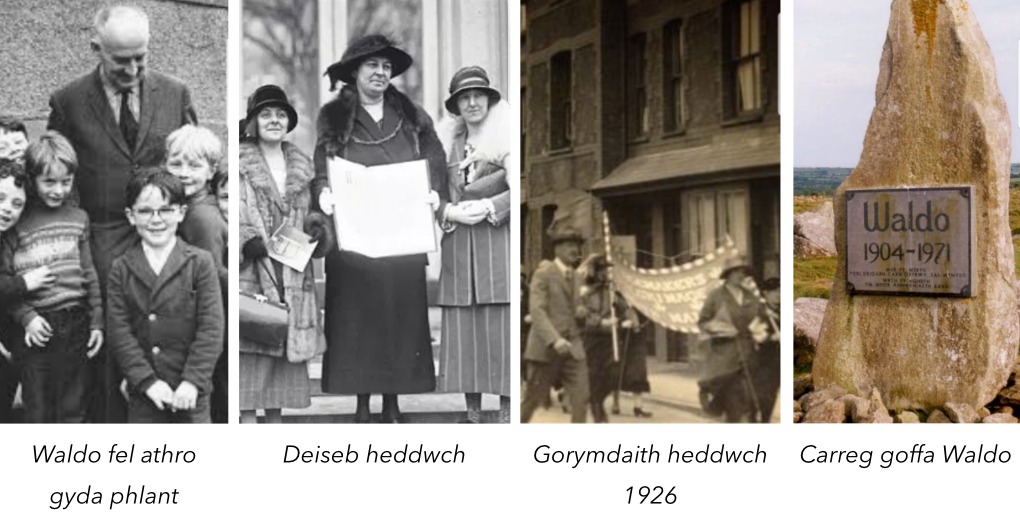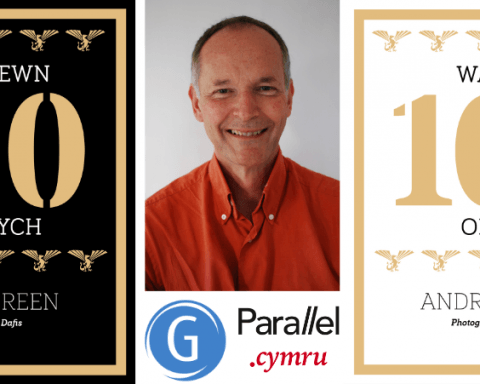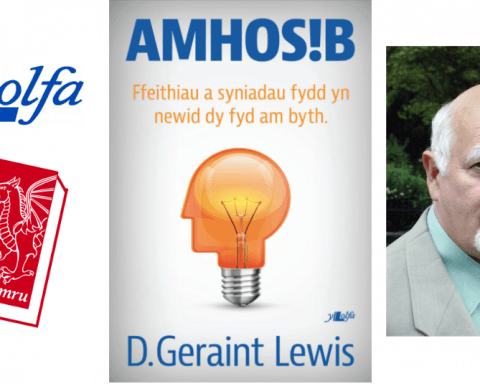Dywedir yn aml fod traddodiad heddychol yng Nghymru. Dechreuodd y traddodiad hwn gyda sylfaenu’r ‘Society for the Promotion of Permanent and Universal Peace’ a gwaith ‘Apostol Heddwch’ Henry Richard. Mae’r aelodaeth o sefydliadau heddychlon wedi cynnwys deallusion, diwinyddion, athrawon ac ysgrifenwyr sydd wedi cael dylanwad sylweddol ar ddiwylliant yng Nghymru. Yn aml daethon nhw o gymunedau agos, Cymraeg eu hiaith, oedd ffynhonnell syniadau allweddol yn heddychiaeth Gymraeg. Ymhellach, roedd y naill heddychwyr yn arfer nabod, ysbrydoli, a helpu'r llall. Dros amser, datblygodd heddychiaeth Gymraeg o fod yn fudiad oedd yn gwrthwynebu rhyfel i fod yn fudiad â phwrpas cymdeithasol ehangach. Wedi dweud hynny, mae llais taer a heriol i heddychiaeth yng Nghymru. Yma, mae Linden Peach yn archwilio datblygiad heddychwch yng Nghymru trwy waith sawl awdur a bardd. Mae'n esbonio bod heddychiaeth yn aml yn cael ei thrafod wrth gyfeirio at ryfela, ond yn dadlau ei fod yn bwysig gweld heddychiaeth mewn cysylltiad ag agwedd ehangach at fywyd, a bod ei pherthynas â heddwch yn bwysig hefyd.
It is often said that there is a pacifist tradition in Wales. This tradition began with the founding of the ‘Society for the Promotion of Permanent and Universal Peace’ and the world of the 'Apostle of peace' Henry Richards. The membership of pacifist institutions has included intellectuals, theologians, teachers and writers, which has had a significant influence on culture in Wales. Often, they came from close, Welsh-speaking communities, which were the source of key ideas in Welsh-language pacifism. Furthermore, the pacifists used to know, inspire, and help each other. Over time, Welsh-language pacifism developed from being a movement which opposed war to being one with a wider social purpose. Having said that, pacifism in Wales has an insistent and challenging voice. Here, Linden Peach, Director of Educational Development at The Prince's School of Traditional Arts in London, researches the development of pacifism in Wales through the work of several authors and poets. He explains that pacifism is often discussed with reference to war, but argues that it is important to see pacifism in the context of a wider world-view, and that its relationship with peace is important too.
| Dywedir yn aml fod traddodiad heddychol yng Nghymru. Dechreuodd y traddodiad hwn gyda sylfaenu’r ‘Society for the Promotion of Permanent and Universal Peace’ (1816) a gwaith ‘Apostol Heddwch’ Henry Richard (1812-1888), Aelod Seneddol Merthyr Tudful a ddisgrifiwyd fel aelwyd heddychiaeth Gymreig. Bu llawer o ddigwyddiadau pwysig sydd wedi dangos y gefnogaeth i heddwch a heddychiaeth yng Nghymru. Mae’r digwyddiadau hyn wedi cynnwys, er enghraifft, neges ewyllys da a anfonwyd gan blant o Gymru at blant y byd; y ddeiseb at lywodraeth Taleithiau Unedig America yngylch aelodaeth o Gynghrair y Cenhedloedd a lofnodwyd gan 60 y cant o fenywod yng Nghymru; y gorymdaith heddwch o ogledd Cymru i Lundain ym 1926 dan arweiniad Gladys Thoday a Sylvan Roberts; a gorymdaith y grŵp Cymreig ‘Women for Life on Earth’ i Greenham Common ym 1981. | It is often said that there is a pacifist tradition in Wales. This tradition began with the founding of the ‘Society for the Promotion of Permanent and Universal Peace’ (1816) and the work of the ‘Peace Apostle’ Henry Richard (1812-1888), Member of Parliament for Merthyr Tydfil, described as the home of Welsh pacifism. There have been many important events that have shown the support for peace and pacifism in Wales. These events have included, for example, a goodwill message sent by the children of Wales to the children of the world; the petition to the government of the United States of America concerning membership of the League of Nations which was signed by 60% of the women in Wales; the peace pilgrimage from the north of England to London in 1926 under the leadership of Gladys Thoday and Sylvan Roberts; and the march of the Welsh group ‘Women for Life on Earth’ to Greenham Common in 1981. |
| Er hynny, mae rhai haneswyr yn anghytuno ac yn cadarnhau bod aelodaeth o gyrff heddychol yng Nghymru wedi tyfu a lleihau. Ond nid maint yr aelodaeth sy’n bwysig. Mae’r aelodaeth o sefydliadau wedi cynnwys deallusion, diwinyddion, athrawon ac ysgrifenwyr sydd wedi cael dylanwad sylweddol ar ddiwylliant yng Nghymru. | Despite this, some historians disagree and affirm that membership of pacifist organisations in Wales has waxed and waned. But it is not the size of the membership that is important. The membership of the organisations has included intellectuals, theologians, teachers and writers, which has had a significant influence on culture in Wales. |
| Yn achos Cymru, mae’r deallusion hyn wedi bod yn bennaf (ond nid yn unig) yn siaradwyr Cymraeg a gafodd eu magu mewn ardaloedd gwledig, fel arfer yn anghydffurfwyr yng ngorllewin neu yng ngogledd Cymru. Roedd y cymunedau agos hyn yn ffynhonell syniadau allweddol yn heddychiaeth Gymraeg sy’n ei wahaniaethu rhwng heddychiaeth Gymreig a heddychiaeth Saesneg, er enghraifft, mae’r syniadau o ‘frawdoliaeth’ ac ‘adnabod’. Mae’r gair ‘adnabod’ yn anodd i’w gyfiethu. Mae’n golygu ‘cydnabod y posibiliadau ysbrydol mewn pobl eraill’. Datblygwyd y cysyniadau hyn ym marddoniaeth David Gwenallt Jones a Waldo Williams. Rwy’n trafod yn fy llyfr sut mae gwaith y ddau awdur Cymraeg yn cynrychioli’n arbennig galon ysbrydol heddychiaeth yng Nghymru yn y 1930au a’r 1940au. Ond rwy’n dadlau hefyd mai eu hagwedd ysbrydol tuag at heddychiaeth sy’n gwneud eu gwaith yn berthnasol hyd heddiw. | In the case of Wales, these intellectuals have been mainly (but not exclusively) Welsh speakers who had their upbringing in rural regions, generally as Nonconformists in north-west or north Wales. These close communities were a key source of ideas in Welsh pacifism, which is distinguished from English pacifism in, for example, the concepts of ‘brotherhood’ and ‘adnabod’. The word ‘adnabod’ is difficult to translate. It means ‘to recognise the spiritual potential in other people’. These concepts were developed in the poetry of David Gwenallt Jones and Waldo Williams. In my book I discuss how the work of the two Welsh authors is particularly representative of the spiritual heart of pacifism in Wales in the 1930s and 1940s. But I argue too that it is their spiritual attitude towards pacifism that makes their work relevant even today. |
| Mae’r Gymraeg yn ffactor pywsig sy’n gwahaniaethu rhwng heddychiaeth Gymraeg a heddychiaeth Saesneg. Cefnogodd heddychwyr Cymraeg eu hiaith yr iaith Gymraeg a chenedlaetholdeb Cymreig gyda chefnogaeth gan rhai o’r wasg Cymraeg. Er nad oedd y wasg i gyd yn cefnogi pasiffistiaeth, roedd yn llwyfan ar gyfer syniadau a dadleuon yn berthnasol i heddychwyr. Mae’r dadleuon ac ymrysonau ymhlith heddychwyr Cymraeg yn cael eu harchwilio yn Outside the House of Baal (1965), sy’n pontio hanner cyntaf yr ugeinfed ganrif, gan Emyr Humphreys, tra mae’r pwysau ar bobl ifanc yng Nghymru yn y 1930au yn cael eu dramateiddio yn ei nofel fodernaidd A Toy Epic (1958). Rwy’n trafod y nofelau hyn ill dwy yn fy llyfr. | The Welsh language is an important factor in differentiating Welsh and English pacifism. Welsh pacifists supported their language, the Welsh language, and Welsh nationalism and enjoyed the support of some of the Welsh press. Although not all the Press were supporters of pacifism, there was a platform for the concepts and arguments relating to pacifists. The discussions and disputes among Welsh pacifists are explored in Outside the House of Baal (1965) by Emyr Humphreys, which spans the first half of the twentieth century, while the pressures on young people in Wales in the 1930s are dramatised in his modernistic novel A Toy Epic (1958). I discuss both these novels in my book. |
| Roedd y ffaith bod y rhan fwyaf o’r heddychwyr yng Nghymru yn siarad Cymraeg a bychanrwydd ac ymhlith cymharol o Gymru yn golygu bod cyfranwyr i’r cyfnodolion Cymraeg yn adnabod ei gilydd ac yn cael eu tynnu at ei gilydd. Roedd hyn yn rhoi hwb i ddatblygiadau o amgylch hedddychiaeth yng Nghymru nad oedd yn digwydd o amgylch heddychiaeth yn Lloegr. Byddai’r naill yn cefnogi’r lleill, ac yn eu hysbrydoli trwy gydol eu brwydrau. Cafodd heddychwyr Cymraeg eu carcharu, collon nhw eu swyddi, ac roedd yn rhaid iddyn nhw wasanaethu fel rhai nad oeddent yn ymladd. Mae llenyddiaeth Gymraeg yn cynnwys ysgrifau carchar a hanesion torcalonnus am ddioddefaint y heddychwyr oherwydd eu bod yn wrthwynebwyr cydwybodol i ryfel, gan gynnwys y canlyniadau iddyn nhw eu hunain, i’w teleuoedd ac i’w ffrindiau. Rwy’n trafod y profiad o gael eich carcharu trwy gyfeirio at y sonedau gan T. E. Nicholas, Llygad y Drws: Sonedau’r Carchar (1940), at ysgrifau carchar George M. Ll. Davies a’r nofel bwysig, Eileen Fleet (1933), gan y nofelydd Iddewig Cymraeg, Lily Tobias. | The fact that the majority of the pacifists in Wales spoke Welsh coupled with the comparatively small size of Wales meant that contributors to Welsh periodicals knew one another and drew support from one another. This gave an impetus to the development of pacifism in Wales that did not happen in the case of pacifism in England. The one would support the other and inspire them throughout their battles. Welsh pacifists were imprisoned, lost their jobs, and had to serve in the manner of other non-combatants. Welsh literature contains prison writings and heartbreaking stories about the sufferings of pacifists on account of their being conscientious objectors to war, including the consequences to themselves, their families and their friends. I discuss the experience of being imprisoned with reference to the sonnets of T.E.Nicholas, Llygad y Drws: Sonedau’r Carchar (1940), to the prison writings of George M. Ll. Davies and to the important novel, Eileen Fleet (1933), by the Jewish-Welsh novelist, Lily Tobias. |
| Datblygodd heddychiaeth Gymraeg o fod yn fudiad oedd yn gwrthwynebu rhyfel i fod yn fudiad â phwrpas cymdeithasol enhangach. Dylanwadwyd ar y datblygiad hwn gan dwf sosialaeth ar ôl y Rhyfel Byd Cyntaf ac effaith dirwasgiad economaidd y 1930au. Cwestiwn allweddol i heddychwyr yng Nghymru oedd sut gallai heddychiaeth fel cred ymateb yn effeithiol i gymunedau digalon a thlawd. Rwy’n trafod y pwnc hwn trwy gyfeirio at waith George M. LL. Davies, David Gwenallt Jones a Waldo Williams. Ar ôl yr Ail Ryfel Byd, dechreuodd heddychiaeth ar draws y byd gymryd diddordeb mewn bywyd dynol a byw yng nghysod y bom. Roedd aelodau o sefydliadau heddychol mawr a hedddychwyr o Gymru yn gweld ein gwlad fel cyfrwng newid neu fel cudd-gynhyrfwr. | Welsh pacifism developed from being a movement opposed to war into a movement with a wider international purpose. This development was influenced by a growth of socialism after the First World War and the effect of the economic depression of the 1930s. A key question for pacifists in Wales was how pacifism as a creed could respond effectively to depressed and poor communities. I discuss this point through reference to the work of George M. LL. Davies, David Gwenallt Jones and Waldo Williams. After the Second World War, pacifism across the world began to concern itself with human life and living in the shadow of the bomb. Members of great pacifist movements and Welsh pacifists saw our country as a medium or secret agent of change. |
| Ffynnai heddychiaeth yng Nghymru mewn cymunedau lle roedd pobl yn arfer byw yn agos iawn at natur. Mae hyn yn golygu ei bod wedi gwerthfawrogi bob amser ansawdd bywyd, cynaliadwyedd, cadwraeth y byd naturiol a heddwch. Ond yn hanesyddol roedd yr ardaloed o ble roedd heddychiaeth Gymreig yn tarddu yn ardaloedd lle roedd protestio’n aml ddigwydd, ac mae hyn wedi rhoi llais taer a heriol i heddychiaeth yng Nghymru. Mae’r llais hwn yn dylanwadu ar lawer o awduron Cymraeg heddiw. Rwy’n archwilio’r pwnc hwn trwy gyfeirio at y nofel gan Angharad Price, O! Tyn y Gorchudd (2003) / The Life of Rebecca Jones (2012) ac at farddoniaeth gan Tony Curtis, War Voices (1995). Mae gwaith Price yn arbennig o ddiddorol oherwydd ei fod yn archwilio pwysigrwydd heddwch i’n cymdeithas a’i synnwyr o berthyn ehangach. Wrth wneud hyn, mae ei nofel yn archwilio’r tebygrwydd rhwng cysyniadau gorllewinol a dwyreiniol ynglŷn â heddwch mewn heddychiaeth yng Nghymru. | Pacifism in Wales flourished in communities where people were accustomed to living very close to nature. This means that they always valued quality of life, sustainability, the stewardship of the natural world and peace. But historically the regions where Welsh pacifism flourished were regions where protest was a frequent occurrence, and this has given a strong and challenging voice to pacifism in Wales. This voice influences many Welsh writers today. I explore this subject with reference to Angharad Price’s novel, O! Tyn y Gorchudd (2003) / The Life of Rebecca Jones (2012) and to the poetry of Tony Curtis, War Voices (1995). The work of Price is particularly interesting because it explores the importance of peace to our society and its experience from a broader perspective. In doing this, her novel explores the similarity between Western and Eastern concepts of peace in pacifism in Wales. |
| Rwy’n dadlau yn fy llyfr fod ystyr heddychiaeth wedi newid yng Nghymru dros amser. Mae’n bwysig gweld heddychiaeth mewn cysylltiad ag agwedd enhangach at fywyd. Yn aml, mae heddychiaeth yn cael ei thrafod dim ond wrth gyfeirio at ryfela. Ond mae ei pherthynas ȃ heddwch yn bywsig hefyd. | I argue in my book that the meaning of pacifism has changed in Wales over time. It is important to see pacifism in connection with a broader attitude to life. Often, pacifism is discussed only with reference to making war. But its relationship with peace is important too. |









